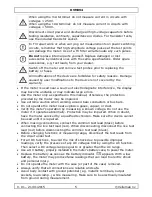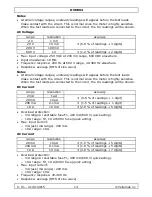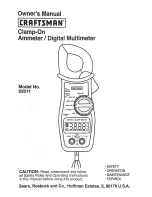
DVM894
V. 01 – 21/01/2015
10
©Velleman nv
Notes
When the input is open, 1 is displayed on the LCD to indicate overload. For
measuring resistance above 1 MΩ, it may take a few seconds to get a steady
reading. This is normal for high-resistance measurement.
7.6
Diode
1.
Plug the black test lead into the COM jack and the red test lead into the
VTempΩ Hz jack.
2.
Set the rotary switch to the position.
3.
Connect the red test lead to the anode and the black test lead to the cathode
of the diode for testing.
4.
Read the value on the LCD.
Notes
The meter will show the approximate forward voltage drop of the diode.
When the test leads are reversed or opened, 1 will appear on the LCD.
7.7
Continuity
TO AVOID ELECTRICAL SHOCK AND INJURY, POWER OFF THE CIRCUIT AND
DISCHARGE THE CAPACITORS BEFORE MEASURING CONTINUITY.
1.
Plug the black test lead into the COM jack and the red test lead into the
VTempΩ Hz jack.
2.
Set the rotary switch to the position.
3.
Connect the test leads to two ends of the circuit. If resistance of the circuit is
less than 50 Ω, the built-in buzzer will sound.
7.8
Capacitance
TO AVOID ELECTRICAL SHOCK AND INJURY, POWER OFF THE CIRCUIT AND
DISCHARGE THE CAPACITORS BEFORE MEASURING CAPACITANCE.
1.
Plug the black test lead into the COM jack and the red test lead into the
hFE mA jack.
2.
Set the rotary switch to the position and select the proper range.
3.
Connect the test leads to two ends of the circuit/capacitor and read the value
on the LCD.
7.9
Frequency Measurement
1.
Plug the black test lead into the COM jack and the red test lead into the
VTempΩ Hz jack.
2.
Set the rotary switch to the Hz position.
3.
Connect the test leads to two ends of the circuit and read the value on the
LCD.
Содержание DVM894
Страница 2: ...DVM894 V 01 21 01 2015 2 Velleman nv ...











































